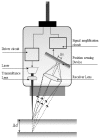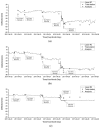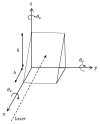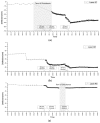Wireless laser range finder system for vertical displacement monitoring of mega-trusses during construction
- PMID: 23648650
- PMCID: PMC3690030
- DOI: 10.3390/s130505796
Wireless laser range finder system for vertical displacement monitoring of mega-trusses during construction
Abstract
As buildings become increasingly complex, construction monitoring using various sensors is urgently needed for both more systematic and accurate safety management and high-quality productivity in construction. In this study, a monitoring system that is composed of a laser displacement sensor (LDS) and a wireless sensor node was proposed and applied to an irregular building under construction. The subject building consists of large cross-sectional members, such as mega-columns, mega-trusses, and edge truss, which secured the large spaces. The mega-trusses and edge truss that support this large space are of the cantilever type. The vertical displacement occurring at the free end of these members was directly measured using an LDS. To validate the accuracy and reliability of the deflection data measured from the LDS, a total station was also employed as a sensor for comparison with the LDS. In addition, the numerical simulation result was compared with the deflection obtained from the LDS and total station. Based on these investigations, the proposed wireless displacement monitoring system was able to improve the construction quality by monitoring the real-time behavior of the structure, and the applicability of the proposed system to buildings under construction for the evaluation of structural safety was confirmed.
Figures
















Similar articles
-
A wireless laser displacement sensor node for structural health monitoring.Sensors (Basel). 2013 Sep 30;13(10):13204-16. doi: 10.3390/s131013204. Sensors (Basel). 2013. PMID: 24084114 Free PMC article.
-
A practical monitoring system for the structural safety of mega-trusses using wireless vibrating wire strain gauges.Sensors (Basel). 2013 Dec 16;13(12):17346-61. doi: 10.3390/s131217346. Sensors (Basel). 2013. PMID: 24351640 Free PMC article.
-
An integrative structural health monitoring system for the local/global responses of a large-scale irregular building under construction.Sensors (Basel). 2013 Jul 15;13(7):9085-103. doi: 10.3390/s130709085. Sensors (Basel). 2013. PMID: 23860317 Free PMC article.
-
Applying Sensor-Based Technology to Improve Construction Safety Management.Sensors (Basel). 2017 Aug 11;17(8):1841. doi: 10.3390/s17081841. Sensors (Basel). 2017. PMID: 28800061 Free PMC article. Review.
-
An overview of wireless structural health monitoring for civil structures.Philos Trans A Math Phys Eng Sci. 2007 Feb 15;365(1851):345-72. doi: 10.1098/rsta.2006.1932. Philos Trans A Math Phys Eng Sci. 2007. PMID: 17255043 Review.
Cited by
-
A practical data recovery technique for long-term strain monitoring of mega columns during construction.Sensors (Basel). 2013 Aug 19;13(8):10931-43. doi: 10.3390/s130810931. Sensors (Basel). 2013. PMID: 23966189 Free PMC article.
-
ADVICE: a new approach for near-real-time monitoring of surface displacements in landslide hazard scenarios.Sensors (Basel). 2013 Jun 27;13(7):8285-302. doi: 10.3390/s130708285. Sensors (Basel). 2013. PMID: 23807688 Free PMC article.
-
A Novel Wireless Low-Cost Inclinometer Made from Combining the Measurements of Multiple MEMS Gyroscopes and Accelerometers.Sensors (Basel). 2022 Jul 27;22(15):5605. doi: 10.3390/s22155605. Sensors (Basel). 2022. PMID: 35957164 Free PMC article.
-
Field monitoring of column shortenings in a high-rise building during construction.Sensors (Basel). 2013 Oct 24;13(11):14321-38. doi: 10.3390/s131114321. Sensors (Basel). 2013. PMID: 24284768 Free PMC article.
-
A wireless MEMS-based inclinometer sensor node for structural health monitoring.Sensors (Basel). 2013 Nov 26;13(12):16090-104. doi: 10.3390/s131216090. Sensors (Basel). 2013. PMID: 24287533 Free PMC article.
References
-
- Hegger J. High-strength concrete for a 186 m high office building in Frankfurt, Germany. Eng. Struct. 1996;11:850–854.
-
- Tatsuya W., Noriyuki F., Yasuo I., Takashi S. Automated construction system for high-rise reinforced concrete buildings. Autom. Constr. 2000;9:229–250.
-
- Abid A., Ribakov Y. Recent trends in steel fibered high-strength concrete. Mater. Des. 2011;32:4122–4151.
-
- Ikeda Y., Harada T. Application of the Automated Building Construction System Using the Conventional Construction Method Together. Proceedings of the 23rd International Symposium on Automation and Robotics in Construction; Tokyo, Japan. 3–5 October 2006.
-
- Hu Z., Zhang J. BIM- and 4D-based integrated solution of analysis and management for conflicts and structural safety problems during construction: 2. Development and site trials. Autom. Constr. 2011;20:167–180.
Publication types
LinkOut - more resources
Full Text Sources
Other Literature Sources
Research Materials

